How to Dehydrate Tomato Sauce or Tomato Puree
If you’ve got more tomatoes than you can freeze or turn into salsa, you may want to consider dehydrating tomato sauce to save room in your freezer. This simple tutorial will share how to dehydrate tomato sauce so you can store it on your pantry shelves and make the most of tomato season.
Why Would You Want to Dehydrate Tomatoes
The number one reason for dehydrating anything is that it takes up so much less space. The finished product is also shelf stable as opposed to taking up room in your freezer.
Dehydrating will even reduce the amount of space you need to store tomatoes on your pantry shelf. Dehydrated tomatoes take much less space than canned tomatoes.
And dehydrating is much more energy efficient than canning or freezing as well.
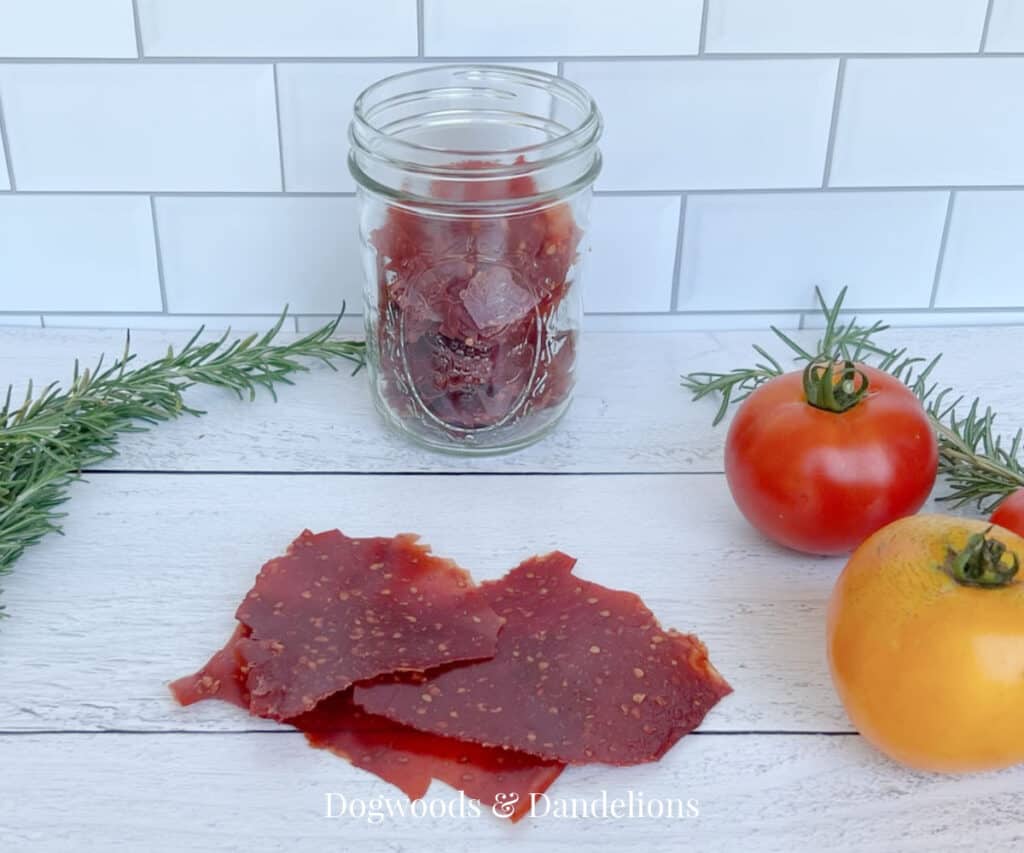
Affiliate Disclosure: Please note that some of the links in this article may be affiliate links and I may receive a small commission if you purchase something through a link. It will not change your cost. As an Amazon Associate, I earn from qualifying purchases. For more information, see my disclosures page.)
Choosing Tomatoes to Dehydrate
While you can certainly use any tomato varieties you have, paste tomatoes will provide the meatiest tomato sauce with less juice. Varieties like Roma tomatoes, San Marzano, and Amish Paste make an excellent sauce.
But if all you’ve got are heirlooms or slicing tomatoes, I would go ahead and use them anyway. While you will have to cook the sauce down a bit longer to remove some of the excess moisture, I wouldn’t hesitate to use them.
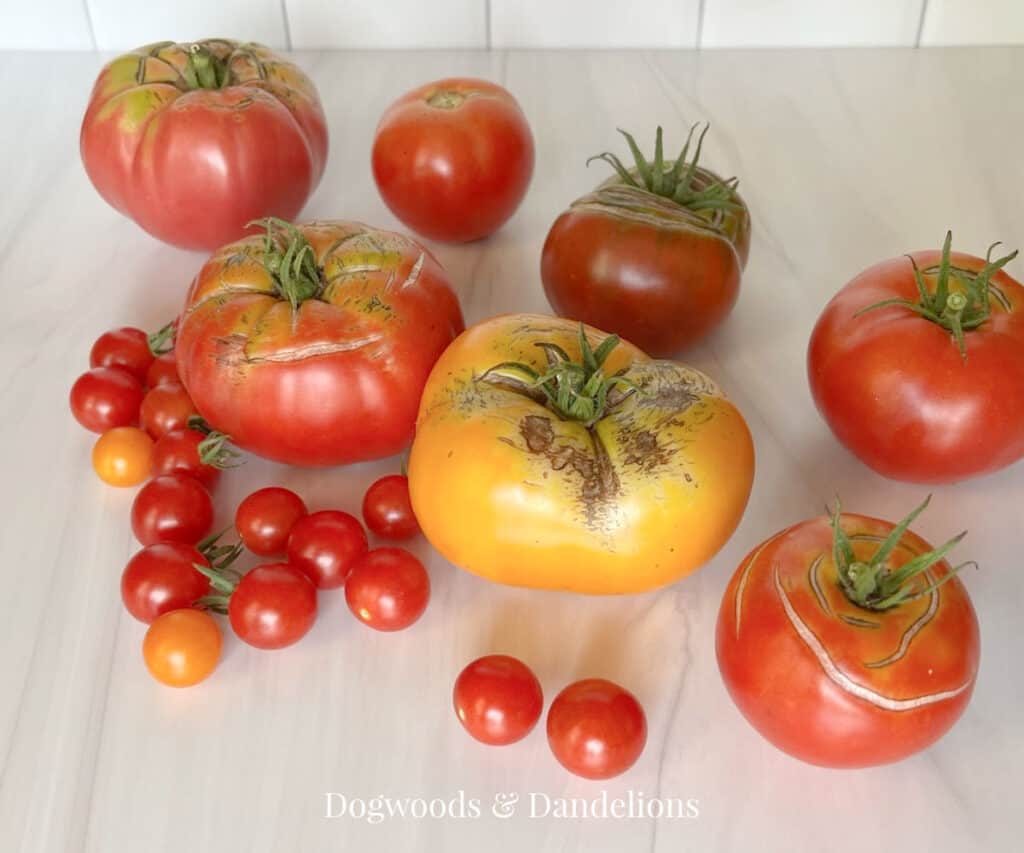
Most of my dehydrated tomato sauce is a mixture of many different types of fresh tomatoes. I think using different varieties gives the sauce a better flavor than using just one kind.
Try to purchase tomatoes from a farmer’s market or produce stand if you aren’t growing your own. Grocery store tomatoes will have a noticeable lack of flavor that will be apparent in your finished sauce.
How to Choose a Dehydrator
Many of us with small kitchens don’t have lots of room for extra appliances. However, I love having a good dehydrator because, in the long run, it actually SAVES space.
I don’t have to have freezer space to store all my tomato products. Plus, once you dehydrate an item, it actually takes up much less space.
I was able to put 6 trays of dehydrated tomatoes in a one-quart jar. This was close to 30 tomatoes.

If you are looking to purchase a food dehydrator, you don’t need a top-of-the-line model. While everyone touts the Excalibur as the end-all-be-all dehydrator, my Nesco has served me well for over 10 years now and it is about one-third the price.
You can also use your oven to dehydrate tomato sauce. However, most ovens only go to about 200 degrees so you will have to watch your tomato sauce carefully to be sure it doesn’t burn.
Using an oven to dehydrate your tomato sauce will also likely lead to a darker finished product.
And if you use the oven, you’ll have to be home (and awake) the entire time it takes to dehydrate the sauce. You should NEVER leave the house or go to sleep with the oven running.
That is a huge fire hazard. (And I should know…my husband is a career fireman with 35+ years of experience!) An inexpensive dehydrator is worth the peace of mind.
How to Make Tomato Sauce (or Tomato Puree) to Dehydrate
Before you can start dehydrating tomato sauce, you first have to prepare your tomatoes. I personally like to peel them, though it isn’t a requirement. I sometimes find, especially late in the season, that tomato skins can be tough and have a bit of a bitter flavor to them.
There are 4 methods for peeling tomatoes: using a paring knife, oven roasting the tomatoes on a sheet pan, using the boiling water method, and freezing the tomatoes.
Read more: How to Peel Tomatoes
Choose whichever method suits you best. I prefer to freeze the tomatoes if I can plan ahead. It takes less time and energy than any of the other methods. My second favorite way is to oven-roast them if I need to get the sauce started today or my freezer is full.
How to Make Tomato Sauce to Dehydrate
Once you have your tomatoes peeled (if you decide to peel them) then it is time to make your tomato sauce. I prefer to make a very neutral tomato sauce. This way, I can add whatever flavor enhancements or spices that I desire later.
We often use dehydrated tomato sauce in Italian recipes, for pizza, or in Mexican recipes. By making a plain tomato sauce, I can adjust the seasonings to match the dish I am preparing.
However, feel free to add any spice you desire as you make your sauce. If you only use tomato sauce in Italian dishes, then, by all means, go ahead and add the spices when you make your sauce.
This is my go-to recipe for making tomato sauce to dehydrate.
There is a printout of the tomato sauce recipe at the bottom of the post. My tomato sauce recipe does use a can of tomato paste but if you prefer to leave that out, you can just cook the sauce down longer.
If you just want to dehydrate tomato puree, just use a food processor or blender to blend the tomatoes together. Tomato puree is different than sauce in that it doesn’t have any seasonings like salt pepper or chopped onion.
If you choose another tomato sauce recipe to use, be sure not to use much oil. While a little olive oil or other oil is okay, using too much oil can cause your dehydrated tomato sauce to go rancid while being stored.
How to Dehydrate Tomato Sauce
Once you have your sauce cooked down to the correct consistency, you will need to pour the sauce onto fruit leather trays to dehydrate. The trays for the Nesco are vastly improved since I purchased mine many years ago. The Excalibur has similar fruit leather trays too.
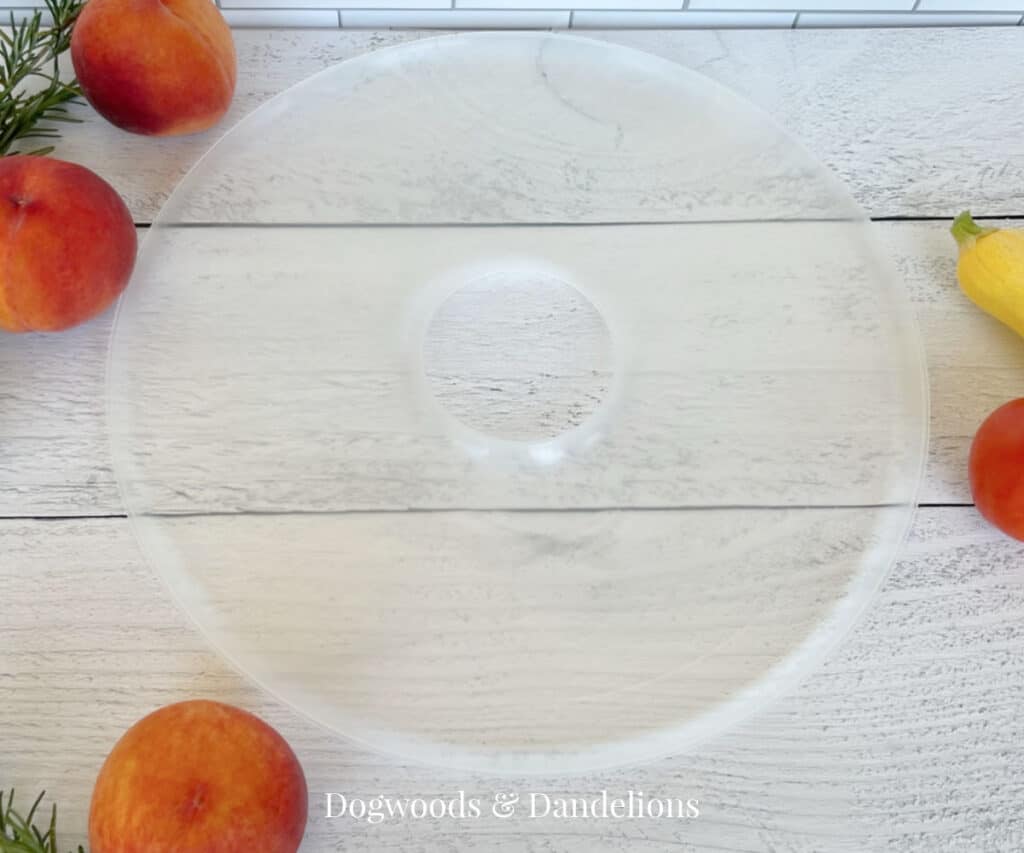
I prefer to allow the sauce to cool briefly before starting my dehydrator. Pour the tomato sauce onto dehydrator trays and spread in a thin layer, approximately 1/4″ thick. The edges will tend to dry quicker so you can mound the sauce slightly toward the outside edge.
Plug the dehydrator in and set the temperature to 125 degrees. The time it takes to dehydrate will depend on your dehydrator and how thick your sauce is.
The higher the water content of the sauce the longer it will take to dehydrate. When fully dry, the sauce should be brittle and feel crunchy. It should also break apart easily in your hands.
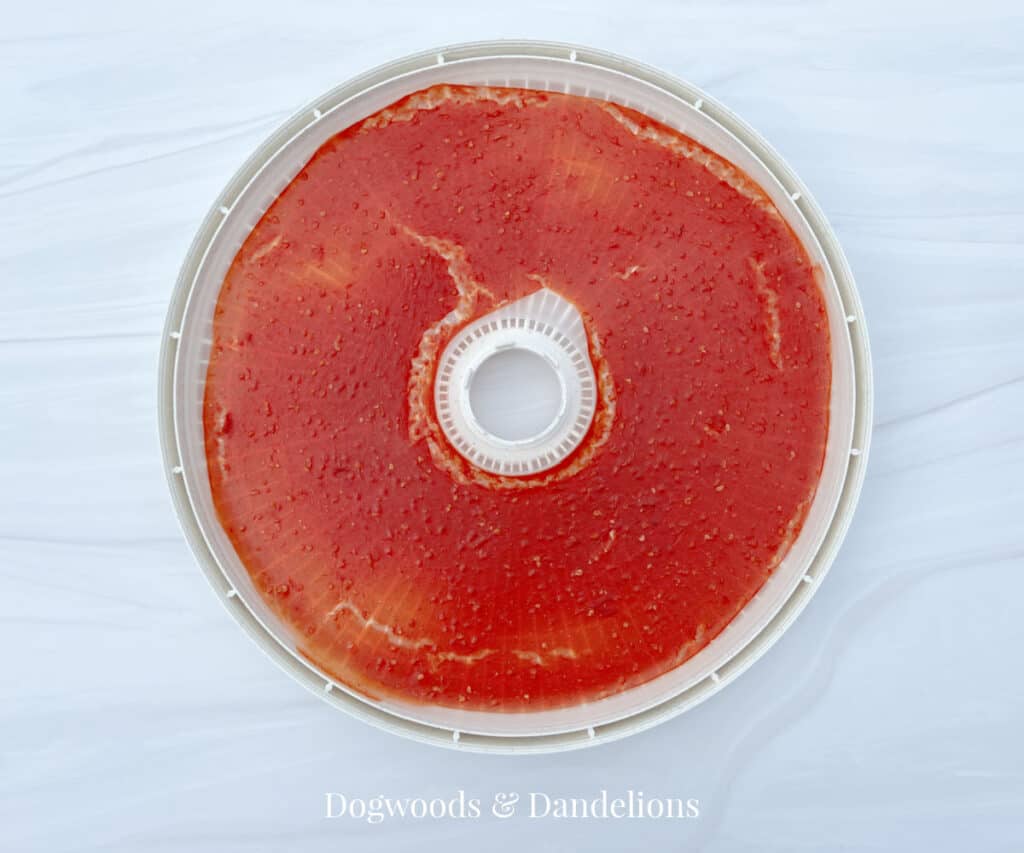
Many times, I will peel the sauce off the dehydrator trays, flip it over, and allow it to dry another couple of hours to ensure it is very dry. Any moisture can cause the whole batch to mold. It is always better to over-dry the tomato sauce as opposed to not leaving it in the dehydrator long enough.
If you are dehydrating tomato sauce in the oven, you will need several large sheet pans. Cut parchment paper to fit your pans, and pour the sauce onto the parchment. Place in your oven at as low a temperature as it will go.
Monitor the tomato sauce very carefully as it dries. The drying time will vary greatly from one oven to the next, especially depending on how much tomato sauce you are drying at one time.
Once dry, peel it from the parchment and store it in one of the ways explained below.
How to Store Dehydrated Tomato Sauce
Dehydrating tomato sauce is basically making tomato sauce leather, similar to fruit leather. Once you dehydrate tomato sauce, you need to store it properly to ensure it lasts until you are able to use it.
I have found the best way to store leather is to pull the sheets of sauce off the trays and tear them into small pieces. Then I place a small amount of the pieces in an airtight container or airtight jar. This is the tomato leather I plan to use soon.
For long term storage I vacuum seal the dehydrated leather in small packets using my Food Saver. To further increase the shelf life of your leather, store these little packets in a mylar bag with oxygen absorbers, they will keep quite a few years. This is the way many preppers store dehydrated food for years and years.
How to Rehydrate Dehydrated Tomato Sauce
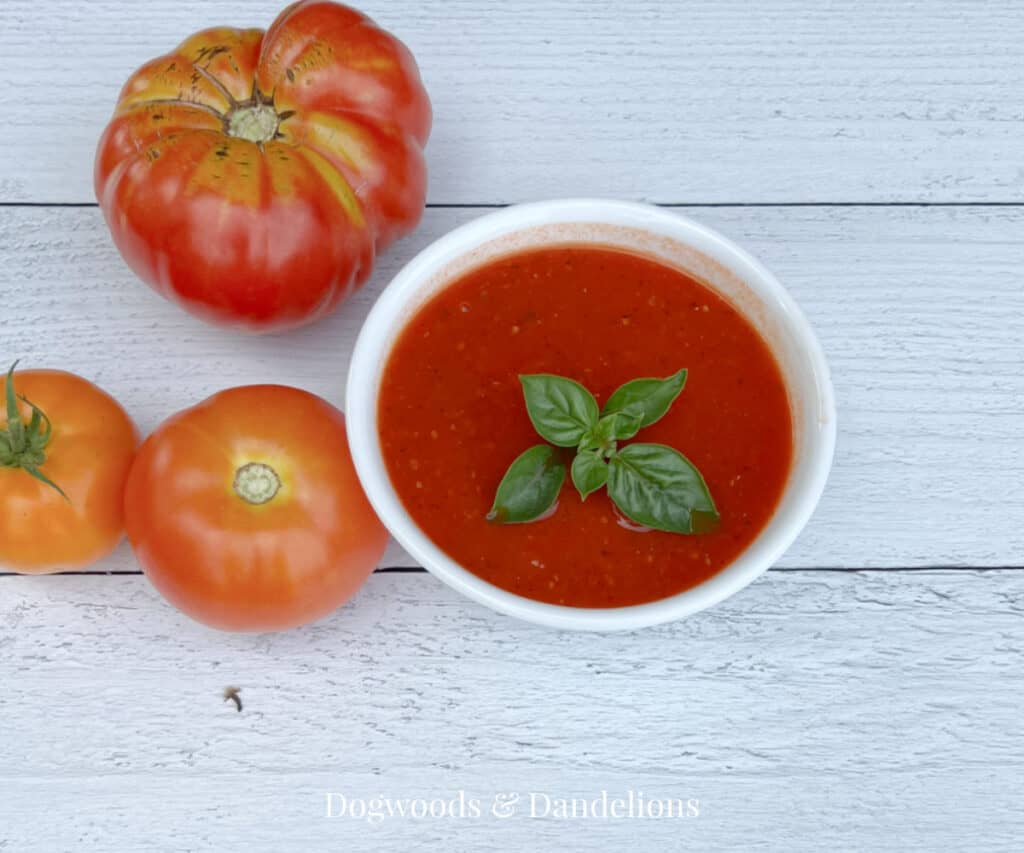
Rehydrating tomato sauce is easy. For 1 cup of tomato sauce, pour 1 cup of boiling water over 1 cup of dehydrated tomato sauce and allow to sit for 15 to 20 minutes. If you want smaller or larger amounts of sauce use equal parts boiling water and dehydrated tomato sauce. So easy!
How to Use Rehydrated Tomato Sauce
Making dehydrated tomato sauce is a great way to use up an abundance of summer tomatoes and produces an end product that has many uses in the kitchen.
You can use your rehydrated tomato sauce in so many ways. Use the tomato sauce to make a delicious pizza sauce for homemade pizza night or in Mexican rice for taco Tuesday.
Use it to replace a jar of marinara sauce in your favorite Italian dish, adding fresh herbs and Parmesan cheese to make a delicious red sauce.
If you do any backpacking or camping or want to make up some dehydrated meals, tomato leather will be a great thing to have on hand.
Dehydrating Tomato Sauce is So Easy
Dehydrating tomatoes as tomato sauce takes up so little space you will wonder why you ever spent time slaving over the stove in the hot summer canning tomatoes. In the middle of winter you will be so thankful you put up your own food for later.
If you want to learn more ways to use your dehydrator, check out my favorite book on dehydrating, The Ultimate Dehydrator Cookbook. Not only does it cover how to dehydrate fruits, vegetables, and herbs, it also shares many recipes to use your dehydrated foods too.
Related Posts
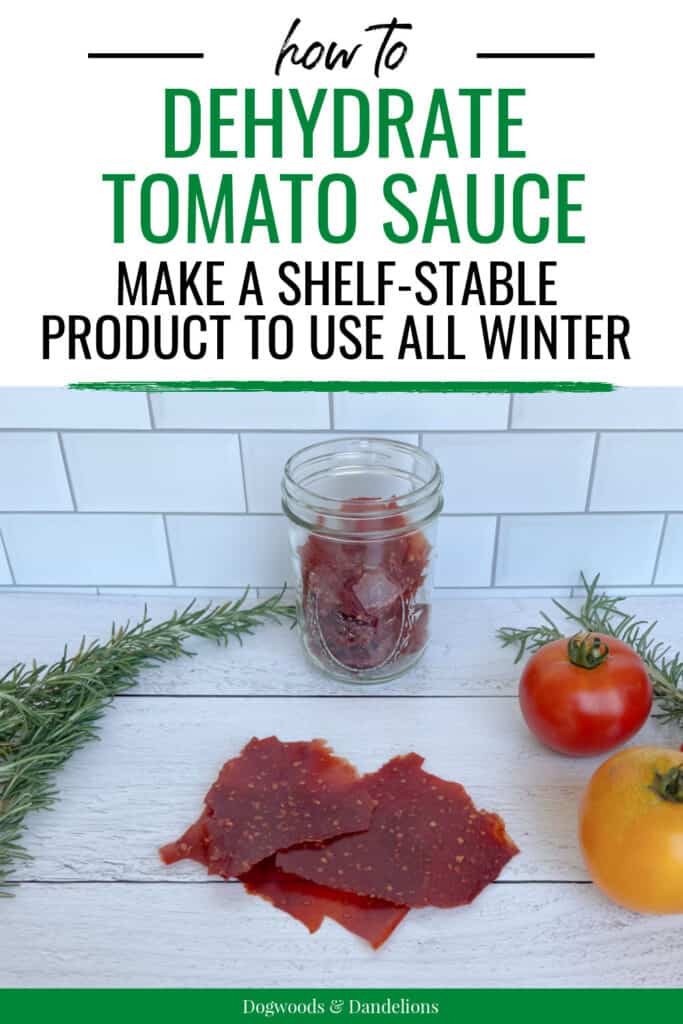

Learn how to make tomato sauce that can be frozen with fresh tomatoes.
- 12 pounds fresh tomatoes
- 1 Tbsp. extra-virgin olive oil
- 1 large onion
- 4 cloves garlic, minced
- 2 tsp. salt
- 1 1/2 tsp. black pepper
- 1 6 oz. can tomato paste, optional
- dried herbs, optional
-
Peel your tomatoes. While not absolutely necessary, you will have a smoother, less bitter sauce by taking the time to peel them.
-
Remove the cores from the tomatoes and add to a food processor or blender. Puree until smooth. Add tomato puree to a large bowl. You will have to do this in batches, a few tomatoes at a time.
Alternatively, you can use a food mill to process the tomatoes which will remove the skins and puree the tomatoes in one step.
-
In a large stockpot, heat extra-virgin olive oil over medium heat. Add onion and saute until tender. Add garlic and saute one minute longer.
Pour in tomato puree. Add salt and pepper. Stir until all is combined.
-
Bring the mixture to a simmer and cook for 2 or more hours until sauce reaches desired consistency. Add the tomato paste and dried herbs if you plan to use them as the sauce nears desired thickness.
Taste the sauce (Be careful, it is hot!) and add any additional seasoning you desire.
-
Remove the sauce and allow to cool. I like to prepare an ice bath in my sink and sit the stockpot in the sink to bring the sauce to room temperature quicker.
Once sauce is cool, ladle into freezer bags or containers and freeze. I personally like to chill the tomato sauce in the refrigerator until it is really cold before transferring it to the freezer. It seems to help prevent ice crystals from forming.

